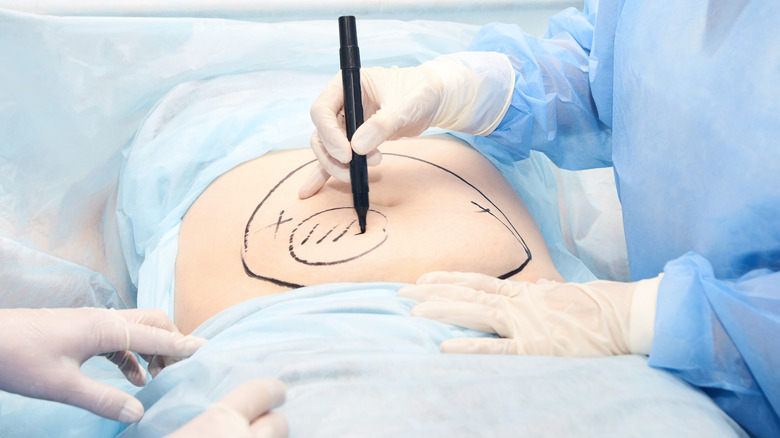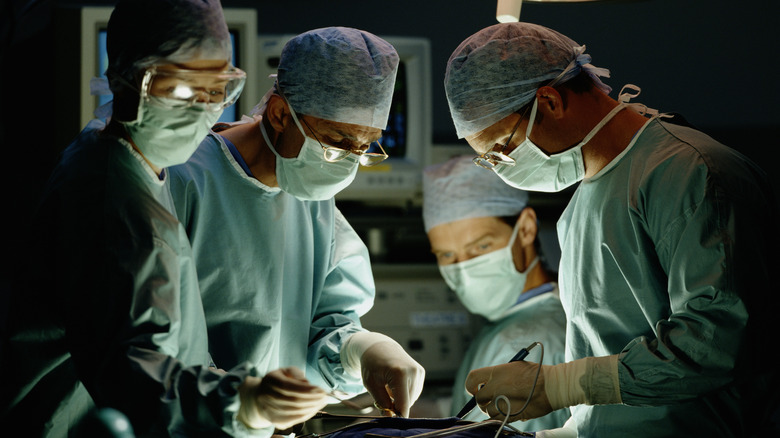What To Expect When Getting A Tummy Tuck
Few cosmetic surgeries are as well known as the abdominoplasty, otherwise known as the tummy tuck. It's one of the go-to procedures that people seem to think of when they bring up cosmetic surgery. And there's a good reason for that — the American Cosmetic Association lists tummy tucks as one of the most common cosmetic procedures. It's up there with nose jobs, breast augmentation, and facelifts.
Tummy tucks aren't purely cosmetic, of course. They may be used to address a weak abdominal wall, which increases the risk of abdominal wall hernias, according to the University of Michigan. In their mild form, these don't present many symptoms other than a small lump or bulge under the skin and some discomfort. Hernias can become strangulated, however, which can lead to more severe symptoms such as vomiting and intense pain. They can also post a risk of fatality if not treated.
There are some doctors who believe tummy tucks during treatment for certain hernias may help prevent the issue from recurring. The American Society of Plastic Surgeons (ASPS) states that combining a tummy tuck with hernia repair surgery may not only avoid repeat issues but also reduce cost as well as the patient's recovery time. Ultimately it comes down to each patient's needs, depending on a conversation with their doctor.
Whether you're getting a tummy tuck for therapeutic or cosmetic reasons, here are some things to expect regarding the surgery.
Preparations for getting a tummy tuck
A key factor you want to consider prior to getting a tummy tuck, particularly if you live in the United States, is whether your insurance will cover any part of the procedure. The Cleveland Clinic explains that most insurance companies won't cover elective cosmetic surgeries, but that specific medical providers may write to a patient's insurance company and get partial coverage if the surgery is medically necessary, like in the instance of a hernia that can be treated by the surgery.
Even if your insurance covers part of the procedure, the Cleveland Clinic goes on to say that cosmetic surgery may raise your premiums or affect your future coverage eligibility. They suggest making and maintaining contact with your insurance company early on to avoid any unfortunate surprises.
Medically speaking, there are several steps to preparing for a tummy tuck. The Mayo Clinic states that your medical provider will review your medical history and do a physical exam. They will also discuss what you hope to get out of the procedure, in part to determine what type of tummy tuck you will get. Your doctor may also suggest that you give up smoking or stop taking certain medications prior to the procedure, and alter your diet or activity level to ensure you can maintain a stable weight. Finally you will likely be told to arrange help for the weeks following surgery so you don't over-exert yourself and damage the incision site.
The process itself
The ASPS states that the tummy tuck process begins with anesthetic. This can be inhaled or received intravenously, depending on what the surgeon feels is best for the patient. This practice is generally safe and side effects are usually limited to post-operative confusion, nausea, chills, and sore throat (if you require a breathing tube), among a few others, according to the American Society of Anesthesiologists.
Once the patient is under, the surgeon will make a horizontal cut in the skin between the lower belly and the patient's pubic area (via the ASPS). Some patients may also receive a second incision in the upper belly if they have excess skin in that area as well. The surgeon will then remove the excess skin and repair any weakened or damaged muscles before pulling the skin back into place, fashioning a new hole for the belly button and suturing closed all of the incisions.
After the surgery, My Health Alberta says that the patient will be sore for at least the first week post-operation. Patients may feel fatigue for five to six weeks as their body heals from the procedure. Although the site encourages patients to avoid lifting or strenuous activity, it also says patients should try to walk each day, in addition to moving their feet and legs after sitting for long stretches. The skin of the patient's stomach may also be numb for several weeks to several months, but that feeling should slowly return.



